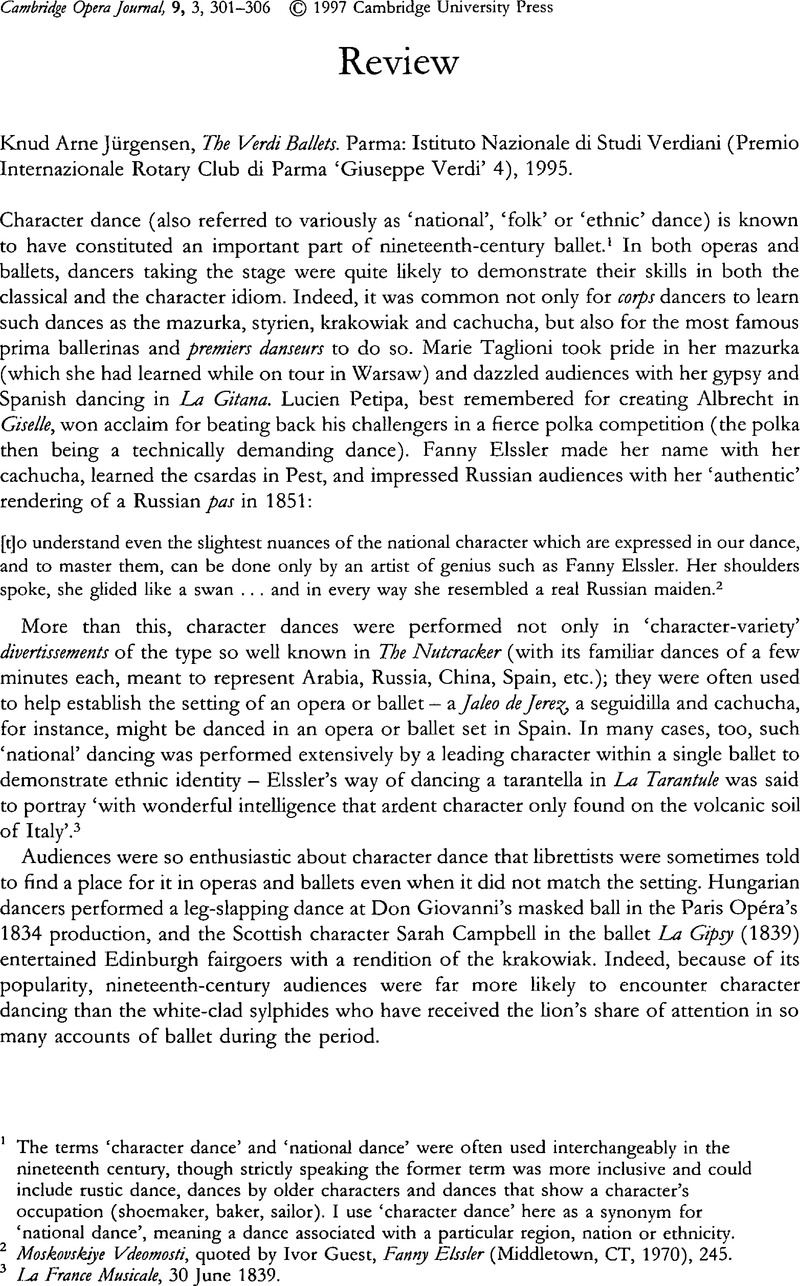No CrossRef data available.
Published online by Cambridge University Press: 27 August 2008

1 The terms ‘character dance’ and ‘national dance’ were often used interchangeably in the nineteenth century, though strictly speaking the former term was more inclusive and could include rustic dance, dances by older characters and dances that show a character's occupation (shoemaker, baker, sailor). I use ‘character dance’ here as a synonym for ‘national dance’, meaning a dance associated with a particular region, nation or ethnicity.Google Scholar
2 Moskovskiye Vdeomosti, quoted by Guest, Ivor, Fanny Elssler (Middletown, CT, 1970), 245.Google Scholar
3 La France Musicale, 30 06 1839.Google Scholar
4 This lacuna in dance historiography has made it possible, for instance, for the critic David Leonard to write that Coppélia (1870) was ‘one of the first ballets to make use of national dance forms‘ despite the fact that ballet dancers all over Europe had been performing national dances for decades. BBC Music Magazine, ‘Ballet’ Special Issue (1996), 72. (My thanks to Ralph Locke for pointing this out.)Google Scholar
5 An important exception is Ivor Guest, who has provided many details about the performance of character dance in, for example, The Romantic Ballet in Paris (London, 1980)Google Scholar and The Romantic Ballet in England (Middletown, CT, 1972).Google Scholar See also Arkin, Lisa C. and Smith, Marian, ‘National Dance in the Romantic Ballet’, in Rethinking the Sylph: Essays on the Romantic Ballet, Studies in Dance History, 14 (Middletown, CT, 1997), forthcoming.Google Scholar
6 See Conati, Marcello, ‘Ballabili nei “Vespri”. Con alcune osservazioni su Verdi e la musica popolare’, Studi verdiani, 1 (1982), 21–46.Google Scholar
7 He counts the march as a ‘dance form’, listing thirty-seven of them, also listing the mazurka, polka and polonaise as standard ‘dance-forms’, although these were often designated as character or national dances by nineteenth-century choreographers and critics.Google Scholar
8 Pendle, Karin, Eugène Scribe and French Opera of the Nineteenth Century (Ann Arbor, 1979), 389. Among the operas that fail to conform to this rule are Gustave III, Ali-Baba, La Juive, Les Huguenots, Dom Sébastien, Jeanne la folk, L'Enfant prodigue, La Nonne sanglante and L'Africaine. See Pendle's Appendix C, 587–96.Google Scholar
9 As Jürgensen points out in a footnote, ribbons from each costume are attached to the tailor's manuscript record describing these costumes.Google Scholar
10 See, for example, Garafola, Lynn, ‘The Travesty Dancer in Nineteenth-Century Ballet’, Dance Research Journal, 17/2 and 18/1 (1985/1986), 35–40;CrossRefGoogle ScholarMeglin, Joellen, ‘Le Diable boiteux: French Society Behind a Spanish Facade’, Dance Chronicle, 17 (1994), 263–302;CrossRefGoogle Scholar and Arkin, Lisa C., ‘The Context of Exoticism in Fanny Elssler's Cachucha’, Dance Chronicle, 17 (1994), 303–25.CrossRefGoogle Scholar
11 Manning, Susan, Ecstasy and the Demon (Berkeley, 1993), 33–4,Google Scholar and ‘Borrowing from Feminist Theory’, in Proceedings – Society of Dance History Scholars. ‘Retooling the Discipline: Research and Teaching Strategies for the 21st Century’ (1994), 331–4.Google Scholar
12 Jürgensen, The Verdi Ballets, 40.Google Scholar
13 Iconographical evidence tells us that ballet costumes for Hungarian and Polish characterswere often fur-trimmed and worn with heavy boots, which suggests that ballet music used to imply these regions were more likely to evoke images of Winter than Summer, even if the dancers were not wearing these traditional costumes. (As a matter of fact, in the Winter divertissement they wore ‘ice’ costumes of silver lamé and carried for boas.)Google Scholar
14 Allanbrook, Wye Jamison, Rhythmic Gesture in Mozart ‘Le nozze di Figaro’ and ‘Don Giovanni’ (Chicago, 1984).Google Scholar
15 Jürgensen, The Verdi Ballets, 116.Google Scholar